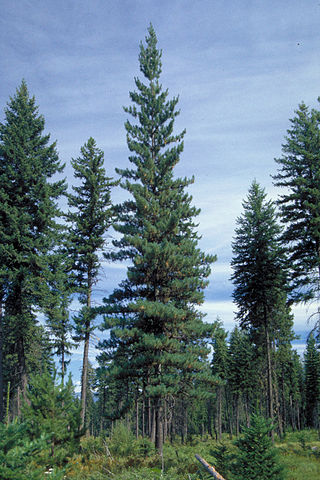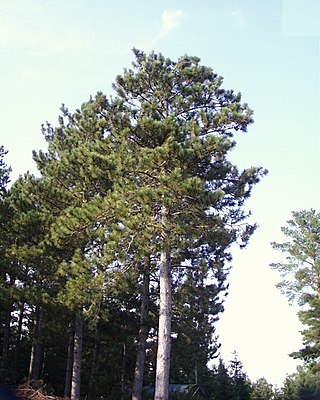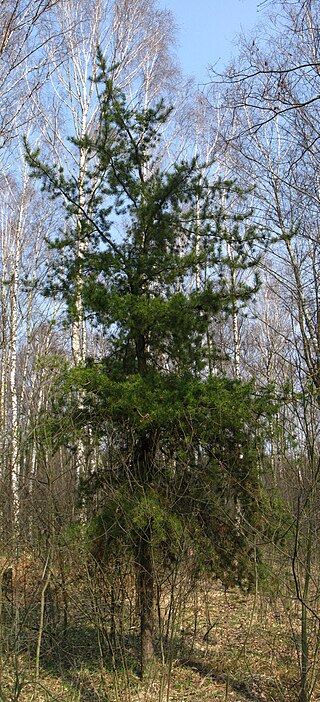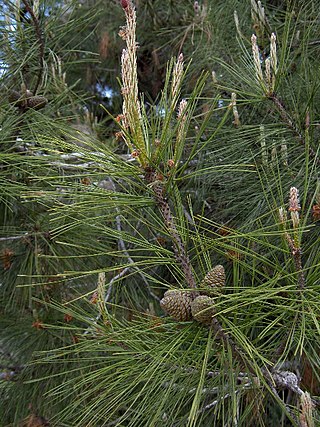
Western white pine, also called silver pine and California mountain pine, is a species of pine in the family Pinaceae. It occurs in mountain ranges of northwestern North America and is the state tree of Idaho.

Pinus nigra, the Austrian pine or black pine, is a moderately variable species of pine, occurring across Southern Europe from the Iberian Peninsula to the eastern Mediterranean, on the Anatolian peninsula of Turkey, Corsica and Cyprus, as well as Crimea and in the high mountains of Northwest Africa.

Pinus jeffreyi, also known as Jeffrey pine, Jeffrey's pine, yellow pine and black pine, is a North American pine tree. It is mainly found in California, but also in the westernmost part of Nevada, southwestern Oregon, and northern Baja California. It is named in honor of its botanist documenter John Jeffrey.

Pinus resinosa, known as red pine, is a pine native to North America.

Pinus echinata, the shortleaf pine, is a species of pine native to the Southeastern United States and Midwestern United States.

Jack pine, also known as grey pine or scrub pine, is a North American pine.

Pinus leiophylla, commonly known as Chihuahua pine, smooth-leaf pine, and yellow pine, is a tree with a range primarily in Mexico, with a small extension into the United States in southeast Arizona and southwest New Mexico. The Mexican range extends along the Sierra Madre Occidental and Sierra Madre del Sur from Chihuahua to Oaxaca, from 29° North Lat. to 17°, between 1600 and 3000 meters altitude. It requires about a rainfall 600 to 1000 mm a year, mostly in summer. It tolerates frosts in winter.

Pinus brutia, commonly known as the Turkish pine, is a species of pine native to the eastern Mediterranean region. The bulk of its range is in Turkey.

Pinus heldreichii, the Bosnian pine or Heldreich’s pine, is a species of pine native to mountainous areas of the Balkans and southern Italy.

Pinus halepensis, commonly known as the Aleppo pine, also known as the Jerusalem pine, is a pine native to the Mediterranean region.

Pinus latteri, or Tenasserim pine, is a pine native to Mainland Southeast Asia.

Pinus johannis, the Johann's pine, is a pine in the pinyon pine group, native to North America. The range extends from southeast Arizona and southwest New Mexico, United States, south in Mexico along the Sierra Madre Occidental and the Sierra Madre Oriental to southern Zacatecas and San Luis Potosí. It occurs at moderate to high altitudes, from 1,600–3,000 metres (5,200–9,800 ft), in cool, dry climate conditions.

Pinus monophylla, the single-leaf pinyon, is a pine in the pinyon pine group, native to North America. The range is in southernmost Idaho, western Utah, Arizona, southwest New Mexico, Nevada, eastern and southern California and northern Baja California.

Pinus quadrifolia, the Parry pinyon, is a pine in the pinyon pine group native to southernmost California in the United States and northern Baja California in Mexico, from 33° 30' N south to 30° 30' N. The Parry pinyon has a lifespan of around 200 to 500 years. It is usually found in rocky areas that often have thin soil. It occurs at moderate altitudes from 1,300 metres (4,300 ft) to 1,800 metres (5,900 ft), rarely as low as 1,200 metres (3,900 ft) and as high as 2,500 metres (8,200 ft). It is scarce and often scattered in this region, forming open woodlands, usually mixed with junipers. Other common names include nut pine and fourleaf pinyon pine.

Pinus aristata, the Rocky Mountain bristlecone pine, is a long-living species of bristlecone pine tree native to the United States. It appears in the Rocky Mountains in Colorado and northern New Mexico, with isolated populations in the San Francisco Peaks in Arizona and the Kaibab National Forest north of the Grand Canyon. It is usually found at very high altitudes, from 7,000–13,000 feet (2,100–4,000 m), in cold, dry subalpine climate conditions, often at the tree line, although it also forms extensive closed-canopy stands at somewhat lower elevations.

Pinus armandii, the Armand pine or Chinese white pine, is a species of pine native to China, occurring from southern Shanxi west to southern Gansu and south to Yunnan, with outlying populations in Anhui. It grows at altitudes of 2200–3000 m in Taiwan, and it also extends a short distance into northern Burma. In Chinese it is known as "Mount Hua pine" (华山松).

Abies amabilis, commonly known as the Pacific silver fir, is a fir native to the Pacific Northwest of North America, occurring in the Pacific Coast Ranges and the Cascade Range. It is also commonly referred to as the white fir, red fir, lovely fir, Amabilis fir, Cascades fir, or silver fir. The species name is Latin for 'lovely'.

Pinus hwangshanensis, or Huangshan pine, is a species of pine endemic to the mountains of eastern China; it is named after the Huangshan Mountains in Anhui, from where it was first described.

Pinus maximartinezii, called Martinez pinyon, big-cone pinyon or maxipiñon, is a pine in the pinyon pine group, native to west-central Mexico.

Pinus massoniana is a species of pine, native to Taiwan, a wide area of central and southern China, and northern Vietnam.























